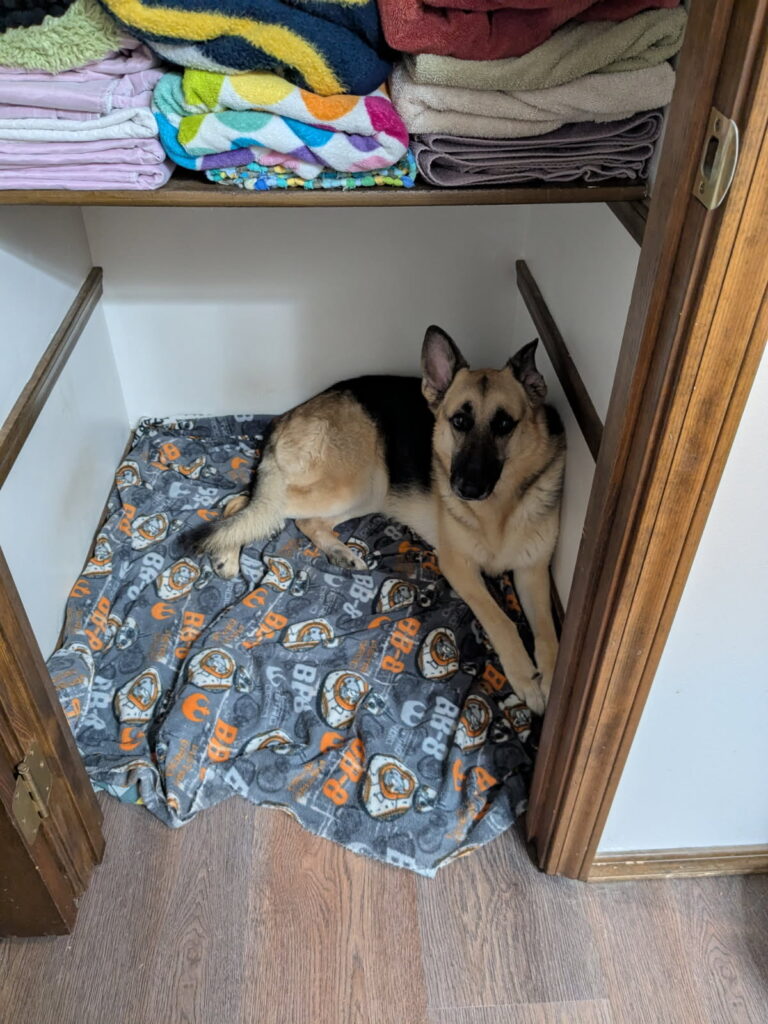Hi, hello. How are you doing? If you’re in the US, we just had the 4th of July, and if you’re like many of my clients, you had a rough one. And realistically, it may not be over depending on where you live and the culture around fireworks.
So, seriously, I’m asking, how are you and your pets doing?
There are a couple of times of year where I consider myself on “standby.” I’m checking in on clients, even if they graduated years ago, to make sure that they are still feeling like they have a handle on the seasons, and June-July is one of those seasons. The toll that those big ol’ booms, or those make-your-eyes-wince whistlers, or the cacophony of little pops has on both pets and their people is real, and big.
For some of us, watching our pets be that afraid, and feeling powerless to do something is gut wrenching.
For some of us, the damage from this week can last months, where our dogs are afraid at night, or won’t go outside.
For some of us, we live in places where fireworks aren’t just a 4th of July thing, or even a night time thing. It is a “whenever this person that lives near me feels like it” thing, and that lack of predictability can be debilitating.
I know that it may seem odd that we’re releasing firework content after the 4th, but for some families, this is the first year their dog struggled, or this is the first year, their current plan didn’t work. So, let’s talk about three elements of preparing for next year: recovery, creating safe spaces, and proactive prep so that next year is a little less chaotic.
After the Boom: Helping Pets Recover from Fireworks
It may seem a little backwards, but let’s start with recovery. Recovery is about helping our pets get back to their baseline and to feel more comfortable and calm in their day-to-day life. We’re looking at helping pets recover from noise, because let’s be honest, it is A LOT.
After the 4th, or really any big boom holiday, it’s common for my clients to see a host of things, and keep in mind this isn’t a comprehensive list, merely just some examples:
- Hiding or self-isolating
- Hypervigiliance, which may look like resting less, radar ears, darty eyes
- Increased flinching or cowering
- Increased “clinginess” or spending more time near their people
- Avoiding things like their collar, harness, or leash
- Avoidance or increased stress when going outside or with windows and doors open
- In some cases, increased aggression
- Resurgence of separation-related problem behaviors
- Hypersensitivity or increased reactivity to additional sounds
If you’re seeing any of these things and have a behavior consultant or trainer on your team, let them and your veterinarian know. It’s really important to keep your care team in the loop. I’ll circle back to this later.
As we are focusing on recovery and helping pets recover after fireworks, we want to return to the basics, the things we have already seen work, keep it simple, and keep it low stress.
To start, get back into a normal, predictable routine. I talked about the importance of predictability in this blog. Even though we have a calendar that we can look at and say, “Oh, look, this weekend there are going to be some big booms!”, our pets don’t have the luxury. This whole thing feels unpredictable to them. So as much as you can, get back into a predictable routine.
If you already have an effective management routine, get it back into place to reduce the number of additional triggers or stressor your pet needs to deal with right now. That might mean no visitors for a couple of weeks. That might be more daycare instead of your pet staying home alone. That might be turning on your sound masking strategies to drown out the sound of other triggers outside and/or your auditory enrichment that helps your pet find their calm.
Get back into the routine of bolstering your pet’s safe space and utilizing the long term calming projects that help your pet fill their cup. We’re going to put all our skills and knowledge into place to help our pets recover at their own pace. For some pets, this can take a while, and some bounce back within a couple of days. If you find your pet is still struggling after a few days, it doesn’t mean you did anything wrong. Phobias are real, they are intense, they take a toll, and sometimes, they take us by surprise. You’re here now, which tells me you love and care about your pet deeply.
Safe vs. Secure: What Sound-Sensitive Pets Really Need

As a reminder, safety and security are two separate, but often intertwined things. Being safe is being protected from harm, while being secure is feeling like you’re protected from harm.
You can be incredibly safe, and not feel secure, and our dog, who is trembling and cowering in the shower, is very, very safe, and really, really doesn’t feel secure.
You can also be incredibly unsafe, and feel very secure, think of the dog who is chasing geese in a field and into the street. They may be having the time of their lives and also, geese. And cars. But mostly, geese.
What we want to do is help our pet feel more secure during these bouts of fireworks or other big booms. We can do this by trial and evaling sound masking to find something that makes the stressful sounds more difficult to perceive.
We can build a safe space, a de-escalation station, a relaxation station–ultimately, a place where our pets can go to feel more secure and cope with their stress. This may be a crate, closet, or bathroom. It may be your lap (if that works for you). It may be a blanket on the end of the couch.
Each dog and family’s safe space is going to look different! Basements and internal bathrooms can be fantastic options for families that have them, and the dog finds them comfortable. Some dogs are going to get really hot when they are stressed, so giving them a cooling mat and a fan is important, while others may need their bed right next to the heat vent.
Some dogs will LOVE white noise. It will, almost instantly, elicit a deep breath and droopy eyelids. But I’ve met plenty who duck their head and shiver instead. This is why trialing different strategies is important!
We want to learn what the calming setup for your sound sensitive pet is! And of course, this may sound simple but it may not be easy, and if you’re struggling or want a second set of eyes to assess your pet’s safe space, that’s what behavior consultants are for!
Proactive Planning: Getting Ahead of the Next Holiday
And friends, that brings us to being proactive. If your pet struggled this year, don’t wait until July 3rd to deal with next July 4th.
Over the next year, take time to:
- Check with your pet’s medical care team to ensure there aren’t any medical conditions contributing to their sound sensitivity or noise phobia. They are incredibly common to see together.
- Talk to your vet about potential medication protocols to assist with the acute events. More on both of these topics in this blog by Veterinary Behaviorist, Dr. Kelly Ballanatyne.
- Work to build, bolster, and use your dog’s safe space throughout the year, starting now. If you’re looking for direct support with this, we’ve got you! I work with many clients to create a sustainable, long-lasting plan to build their pets’ safe space, and will be helping participants through the step-by-step process in my upcoming At Ease: Safe Spaces for Home and On-The-Go live course through the Karen Pyror Academy.
- Store high-value treats around your house, and when you hear any big boom, clang, whistle, car backfire, or [insert more loud, surprising noises here], give your pet that extra special treat. Working to help our pets be comfortable with loud or startling noises doesn’t require the specific loud and startling noise; we can practice that skill throughout the year with whatever life throws at us. Eileen Anderson talks more about this process here.
And again, if this feels like a lot, know that it doesn’t have to be. At Pet Harmony, our main goal for our private clients is that this process is sustainable, do-able, and achievable.
Compassion, Not Perfection
I know it is hard. I know that you may read this, coming off an incredibly stressful weekend and feel like there is no hope, that there is no way that you can do *all the things*, help your pet have a smoother 4th next year, or even bring yourself to do that first step.
Remember, stress takes time to process, so if you’re overwhelmed by everything in this blog, it is okay. That doesn’t make you a bad pet parent and it doesn’t mean that you don’t care about your pet. It means that you’re also a living creature with needs, stress, and responsibilities.
Here’s to harmony,
Ellen
Now What?
If you read this and think, “Yeah, okay! I got this!” Then go get it! That’s awesome.
If you read this and immediately enter the overwhelm spiral, then set an alarm, or put it in your planner, or however you track things, to come back in a week or two after you and your pet have gotten some distance from the event and revisit. You may find it much more digestible then.
If you’re somewhere in the middle and want someone to walk on this journey with you, we’re here for you to help make next year’s 4th much less stressful.
Copyright 2025 Pet Harmony, LLC. All Rights Reserved.
Terms & Conditions, Privacy Policy
Results are not guaranteed because behavior, human, canine, or otherwise, are not guaranteeable.


